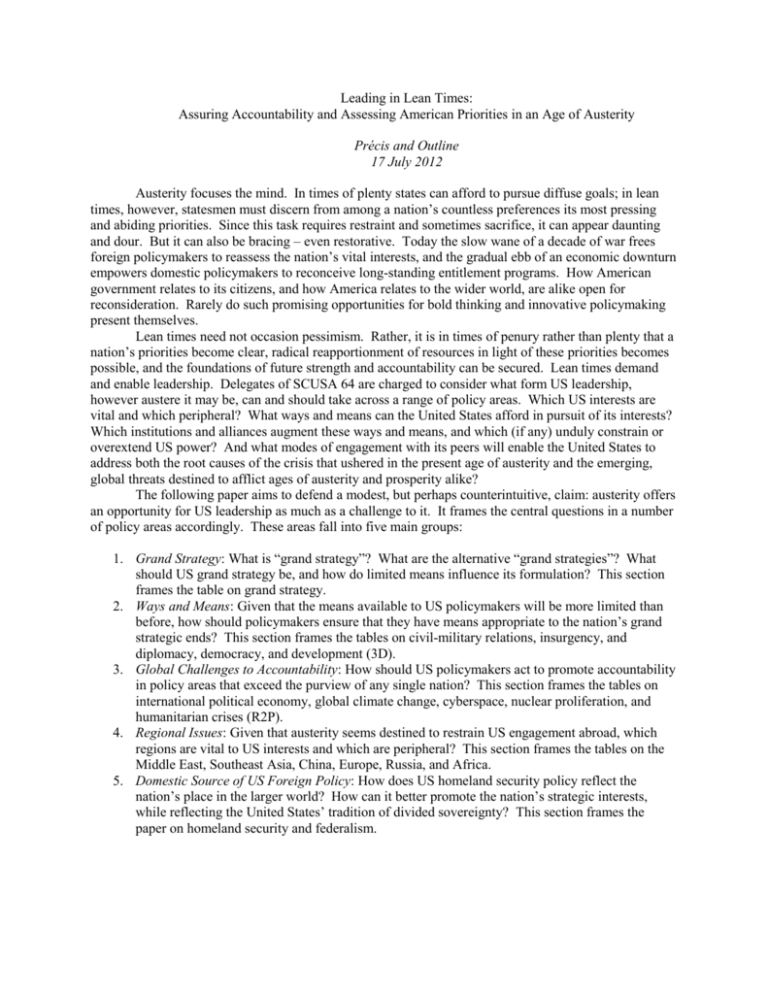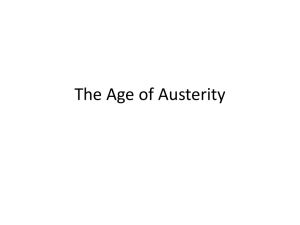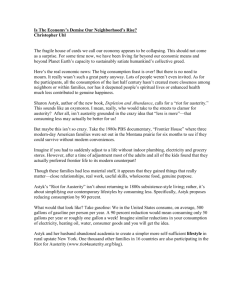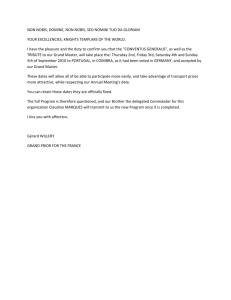SCUSA 64 Theme Paper Precis
advertisement

Leading in Lean Times: Assuring Accountability and Assessing American Priorities in an Age of Austerity Précis and Outline 17 July 2012 Austerity focuses the mind. In times of plenty states can afford to pursue diffuse goals; in lean times, however, statesmen must discern from among a nation’s countless preferences its most pressing and abiding priorities. Since this task requires restraint and sometimes sacrifice, it can appear daunting and dour. But it can also be bracing – even restorative. Today the slow wane of a decade of war frees foreign policymakers to reassess the nation’s vital interests, and the gradual ebb of an economic downturn empowers domestic policymakers to reconceive long-standing entitlement programs. How American government relates to its citizens, and how America relates to the wider world, are alike open for reconsideration. Rarely do such promising opportunities for bold thinking and innovative policymaking present themselves. Lean times need not occasion pessimism. Rather, it is in times of penury rather than plenty that a nation’s priorities become clear, radical reapportionment of resources in light of these priorities becomes possible, and the foundations of future strength and accountability can be secured. Lean times demand and enable leadership. Delegates of SCUSA 64 are charged to consider what form US leadership, however austere it may be, can and should take across a range of policy areas. Which US interests are vital and which peripheral? What ways and means can the United States afford in pursuit of its interests? Which institutions and alliances augment these ways and means, and which (if any) unduly constrain or overextend US power? And what modes of engagement with its peers will enable the United States to address both the root causes of the crisis that ushered in the present age of austerity and the emerging, global threats destined to afflict ages of austerity and prosperity alike? The following paper aims to defend a modest, but perhaps counterintuitive, claim: austerity offers an opportunity for US leadership as much as a challenge to it. It frames the central questions in a number of policy areas accordingly. These areas fall into five main groups: 1. Grand Strategy: What is “grand strategy”? What are the alternative “grand strategies”? What should US grand strategy be, and how do limited means influence its formulation? This section frames the table on grand strategy. 2. Ways and Means: Given that the means available to US policymakers will be more limited than before, how should policymakers ensure that they have means appropriate to the nation’s grand strategic ends? This section frames the tables on civil-military relations, insurgency, and diplomacy, democracy, and development (3D). 3. Global Challenges to Accountability: How should US policymakers act to promote accountability in policy areas that exceed the purview of any single nation? This section frames the tables on international political economy, global climate change, cyberspace, nuclear proliferation, and humanitarian crises (R2P). 4. Regional Issues: Given that austerity seems destined to restrain US engagement abroad, which regions are vital to US interests and which are peripheral? This section frames the tables on the Middle East, Southeast Asia, China, Europe, Russia, and Africa. 5. Domestic Source of US Foreign Policy: How does US homeland security policy reflect the nation’s place in the larger world? How can it better promote the nation’s strategic interests, while reflecting the United States’ tradition of divided sovereignty? This section frames the paper on homeland security and federalism.







